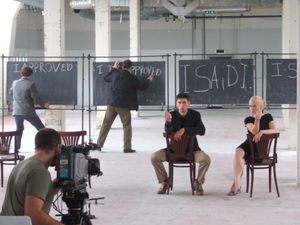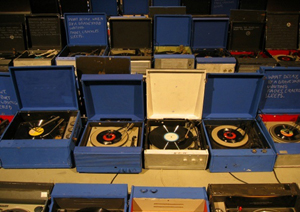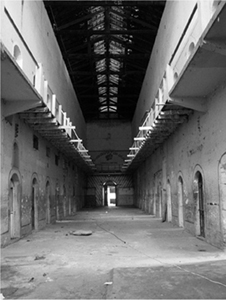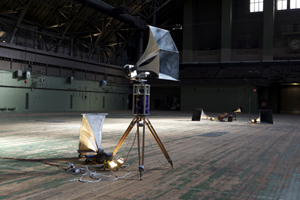Art Echoes Across the Atlantic: No Longer Empty on the Road Sounds Off at the Liverpool Biennial
CHELSEA, MANHATTAN/LIVERPOOL: Open spaces, sight and sound are all fair game for the arts group No Longer Empty (NLE). Now the vision of this NYC group, which temporarily transforms vacant spaces into artistic beehives, is starting to spread out internationally.
For those who have the time – and the scratch for a transatlantic plane ticket – it would be well worth catching NLE’s contribution to the famed Liverpool Biennial, which stands as the largest contemporary visual arts event in the UK. For Manhattan-based Asher Remy-Toledo, Co-Founder of NLE and Founder/Director of NLE on the Road, the invitation to team with the Biennial – which runs through the end of November – represented an irresistible opportunity to channel the group’s visual talents in a sonic direction.
NLE’s Liverpool exhibit gathered together 13 international/local artists using sound as a medium to explore the history of the city. On display for the ears and eyes are such works as Clemencia Echeverri’s Voz, a video project working with sounds that exist within prisons; Jani Ruscica’s NYC-filmed Beatbox video, portraying sound and movement as self-expressive navigational tools; Marina Rosenfeld’s P.A., which uses the complex overhead airspace and daily function of Liverpool’s historic Renshaw Hall — now a garage — as both a reflecting and distorting structure for sound; and Phil Jeck’s Pool of Voices, taking old records and turntables salvaged from junk shops, and playing them as musical instruments.
Hopefully, the evolution of NLE from it’s NYC visual origins to an international program overseeing advanced sound installations can provide Big Apple artistes with inspiration – and a few caveats. Remy-Toledo breaks the journey down for us here.
Why was it important for you personally to co-found NLE – what is your own personal attraction to the concepts it represents?
I was very sad to see so many empty spaces in the city. A lot of artists I knew were leaving town for other places because they couldn’t afford their rents and their galleries were closing or not selling. I moved to NY many years ago attracted by this vibrancy, cutting edge and great art scene, and I thought it was very bad to just see that energy die.
I had seen an art installation the previous year in an old police building in the center of Hong Kong, where the artists used the former prison cells to create site-specific installations that conveyed the claustrophobic size of the room, the lack of freedom. I was taken by it: I realized that exhibition would not have had nearly the same strong impact if it would have been in one whitewall gallery space or museum, and in that moment I was determined to do site-specific installations.
Then one day while having lunch with a friend of mine, Manon Slome, we were discussing the large number of empty spaces in the city. When I mentioned this exhibition I saw and how sad it was to see so many artists leaving town, we immediately decided to partner to create one-time exhibitions using about a dozen spaces in Manhattan and create meaningful site-specific installations that were low-budget.
It’s been fascinating to experience these myself, like with the installation NLE created earlier this year at Tower Records on Fourth Street and Broadway. Why do you think the concept has been so successful so quickly in NYC?
I think the key to our rise has been that we were there at the right time, having had the opportunity to have been involved in the art world for several years, traveled around and seeing how artists respond to spaces and historical moments in unique ways.
The other aspect is that we pay extreme attention to detail, as a museum would. We have a holistic approach where we learn from the art establishment and also from grassroots organizations and guerrilla marketing. Besides being curatorial-based, we have a platform where people interested in working in the arts and gaining skills can come and do it with us. We have recent graduates from urban planning, business administration, arts management, graphic design, people wanting to work on PR, artists, art writers, and more.
It’s great that its so inclusive in that way. So how did that lead to the latest development, which is NLE On the Road?
We’ve had several inquiries from other countries asking if we would be interested in bringing NLE there. I decided to create this other chapter, which is totally independent from the New York group, but inspired by it — we collaborate with each other but have different goals even though we still share some similar missions.

Mayke Nas and Wouter Snoei: "I Delayed People’s Flights By Walking Slowly In Narrow Hallways". Percussion group SDH uses sound enhanced blackboards to create a meeting point between composed music and image, with the audience completing the collaboration, resulting in a new musical composition.
Moving toward the musical portion of our show — how did NLE get involved in the Liverpool Biennial – what did they want to accomplish that made you a good match for the 2010 show?
I ve been going to Liverpool for at least three years doing advisory work for FACT — the Foundation for Art and Creative Technology. I got involved with them when I presented an exhibition at the 798 art district of Beijing parallel to the “Synthetic Times” media technology exhibition in the city. Mike Stubbs the director of FACT happened to come to see it while he was in town — he loved it and invited me go visit Liverpool.
Coming to Liverpool has been very exciting, it’s a very off-beat town where all could go amazingly well or awfully bad — you pretty much have the same chances! The city has grown on me, I have learned to appreciate its insulated, chip-on-the-shoulder attitude which reminds me of New York, but also of China. You need to think differently in order to succeed in Liverpool, because just average doesn’t work.
I had met some landlords that own properties in the Rope Walk area of Liverpool where FACT is located. I decided to join forces with FACT on helping develop this particular neighborhood by attracting artists to the area and making this a Bohemian village.
Sounds like our speed! Why did so many of the projects you put together for the Liverpool Biennial involve the application of music and sound?
Site-specificity is a primordial aspect of No Longer Empty: I selected sound because it is very Liverpool, and live music is everywhere. The city is very vibrant, youthful, intense. But some people in the city can’t relate to the Biennial, because a big part of the city is very working-class and they see these groups of trendy, artsy people taking over the city for three days, then disappearing to the next international event.

The music of Phil Jeck’s “Pool of Voices” is a combination of spoken word and synthetic sounds, forming a uniquely original creation.
I wanted to create something for the Biennial that will talk to new audiences — my interest is not so much to preach to the converted, but more to bring art to new audiences by presenting it in unexpected spaces and helping create social change. I see art as a social catalyst, with the power of getting to people and passing through their filters. That’s why I like public art, because also it takes people by surprise to see something in an unexpected venue.
Nothing like a little artistic jolt, it’s true. What were your criteria for the sound installations you ultimately selected to be in the show? What did they have to express to qualify and make the cut?
They have to be engaging. I’m always interested in art that is visually interesting, but also emotionally and mentally grabbing. I’m trying to attract the city people who live in Liverpool all year around, but I also want to the arts cognoscenti to be equally surprised, pleased and a bit thrown out of their expectations about what to find in a Biennial, where you usually see the usual suspects.
I also have to be aware that I don’t have much budget for this, so it has a lot of grassroots approach in order to make it happen without sacrificing the quality, as I have learned to do in NLE New York. I think that at the time when most art funding has been cut, this is very appropriate for the times.
So many of these installations sound fascinating. I know it’s hard to pick, but which ones are your favorites?
There are some very ambitious projects that I m very excited about it, like the one of Giuseppe Stampone who created five speakers in the shape of “life size” coffins: they play national anthems of countries that have affected the collapse of the world economy. I certainly love the very large installation by Ray Lee and its electromagnetic robots that spin around with lights, creating this surreal and hypnotic visual effect that involves the viewer. Also the one by Phil Jeck is such a poetic installation.

The sounds of “Voz” by Clemencia Echeverri evokes the idea that the voices are the inner core of the body, and yet they are detached from the prisoners, eliminating any sense of identity and reinforcing the forgotten people within the building.
Those are some extreme visions. What were the biggest surprises and challenges you encountered along the way putting these installations together? What did you learn from them that you’d like other people to know, if they’re planning on doing sound art installations?
It’s very difficult to put together something in a country one is not familiar with, especially when it comes to securing a space, bringing electricity to it, hiring workers, marketing, dealing with special interest groups that constantly threaten to shut down the exhibition if money was not paid to them under the table…
All of those are things that if I would have known today the amount of extra money it cost and the amount of work, I wouldn’t have done it. But now I know that it was like passing through a fire-and-ice test!
— David Weiss
Please note: When you buy products through links on this page, we may earn an affiliate commission.








